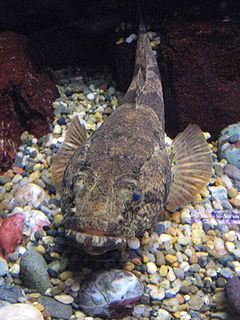
Freshwater sleepers are a small family, the Odontobutidae, of gobiiform fishes native to freshwater rivers flowing into the South China Sea and the northwestern Pacific Ocean. The family consists of about 22 species in six genera.
The tale of Tiddalik the Frog is a creation story from Australian Indigenous Dreaming Stories.

Calymene Brongniart, 1822, is a genus of trilobites in the order Phacopida, suborder Calymenina, that are found throughout North America, North Africa, and Europe in primarily Silurian outcrops. Calymene is closely related to Flexicalymene, and both genera are frequently found enrolled. Calymene trilobites are small, typically 2 cm in length. The cephalon is the widest part of the animal and the thorax usually has 13 segments.

Ranoidea platycephala, commonly known as the water-holding frog, is a frog common to most Australian states. It differs from most other members of the family Pelodryadidae as a ground dweller and the ability to aestivate. It can live for five years without drinking.

The Japanese water shrew, also called the flat-headed water shrew, is a species of mammal in the family Soricidae. It is endemic to Japan.

The twist-necked turtle also known as the flat-headed turtle, is distributed widely across northern South America. Twistoofnecked turtles have extremely flat shells that help them hide from predators under rocks and debris. When threatened, this turtle withdraws by twisting its head into its shell. P. platycephala is the only species of the genus Platemys and occurs in northern and central South America. Platemys platycephala means “flat turtle, flat-head” and accurately describes the structure of the head and shell. This species inhabits shallow creek beds and frequently forages on the floor of the Amazon rainforest for insects, amphibians, and mollusks. Camouflage, head and body shape, and advanced sexual anatomy allow this species of turtle to effectively populate much of South America. Mating occurs during rainy months (March–December) and egg deposit occurs during dry months (January–March). Males have been known to behave aggressively towards females during copulation by squirting water from nostrils and biting. A few genomic studies show mosaicism exists among populations of the twist-necked turtle in Surinam. In other words, diploid and triploid levels exist among individuals at this particular location. No threats have been reported for this species and the International Union for Conservation of Nature does not have a current listing. Lack of human consumption due to the species' small size and its wide range explain why scientists are not concerned about this turtle species.
Platycephala is a genus of flies in the family Chloropidae.
Dewildemania is a genus of African flowering plants in the daisy family.
Alvania platycephala is a species of minute sea snail, a marine gastropod mollusk or micromollusk in the family Rissoidae.

Odontobutis is a genus of freshwater sleepers native to East Asia and Vietnam.
Odontobutis sinensis is a species of freshwater sleeper endemic to China.
Odontobutis yaluensis is a species of freshwater sleeper endemic to China.
Odontobutis potamophila is a species of freshwater sleeper native to China and Vietnam, is a commercially important fish species used in aquaculture in China. Demonstrating a sexually dimorphic growth pattern where the male grows quicker and larger than the female, this species can reach a length of 11.5 cm (4.5 in) in standard length.
Caffromorda platycephala is a species of beetle in the family Mordellidae, the only species in the genus Caffromorda.
Halaphritis platycephala is a species of thornfish native to the oceans off of Tasmania (Australia) where it can be found at depths of from 5 to 13 metres preferring caves and other low-light habitats. This species grows to a standard length of 16.8 centimetres (6.6 in). This species is the only known member of its genus.
Lesueurina platycephala, the Flathead pygmy-stargazer, is a species of southern sandfish endemic to the coastal waters of southern Australia. It occurs in areas with a sandy substrate and turbulent waters at depths of from near the surface to 1 metre (3.3 ft). This species grows to a length of 11 centimetres (4.3 in) SL. This species is the only known member of its genus. It is an ambush predator which occurs from Fraser Island in Queensland south along the Australian coast, including Tasmania, and west to Coral Bay, Western Australia. The generic name honours the French artist and naturalist Charles Alexandre Lesueur (1778-1846) who visited Australia on the vessels Géographe and Naturaliste under the leadership of Nicolas Baudin (1880-1804) and who later worked as an ichthyologist in the Academy of Natural Sciences of Philadelphia.
Garra platycephala is a species of cyprinid fish in the genus Garra which is found in India.

Ligia platycephala is a species from the genus Ligia.







